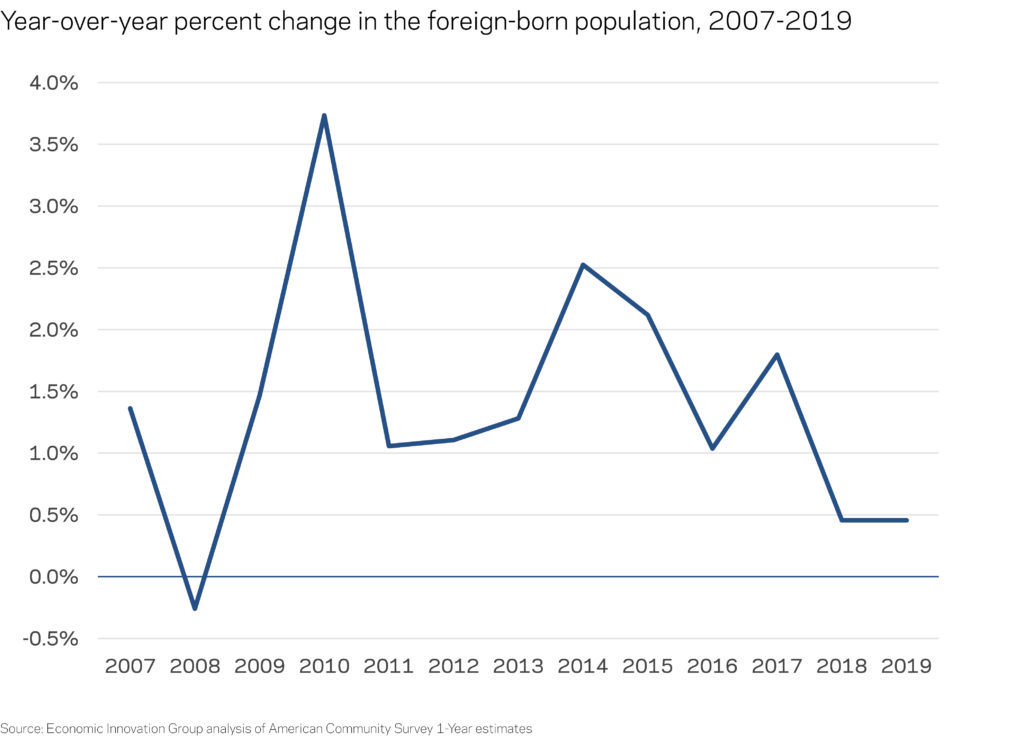By August Benzow
The White House announced last week that it will suspend new work visas until the end of the year. This executive order effectively shuts down the pipeline of H-1B visa holders, seasonal workers in the hospitality industry, students working summer jobs, and child care workers such as au pairs. This is in addition to extending restrictions on the issuance of new green cards and blocking visas for international students who are forced to take classes entirely online due to the pandemic. Combined, these measures have the potential to keep over half a million foreign workers out of the country through the end of the year.
The administration argues that the executive order is necessary to safeguard employment opportunities for domestic workers, nearly 20 million of whom are unemployed right now, in the face of an unprecedented economic crisis. In reality, this pretext is a complete misrepresentation of the vital role immigrants play in the U.S. economy both in times of prosperity and in times of economic crisis.
Immigration has already dropped significantly
Although the total number of immigrants (foreign-born residents) in the United States has continued to slightly increase since Trump took office, the rate of increase has plummeted to its lowest level since the Great Recession.
These national trends meaningfully impact local economies, as most counties now see fewer immigrants each year. In 2019, just 454 counties saw more international migration than they did the year prior. By comparison, immigration rose in 1,548 counties over the course of 2015, equating to nearly half of all counties nationally. Closing the country’s doors on more immigrants will make it harder for places to keep their populations stable or growing. Already in 2019, 72 percent of counties would have experienced slower population loss or quicker population growth if they had welcomed the same number of new immigrants as they did in 2015.
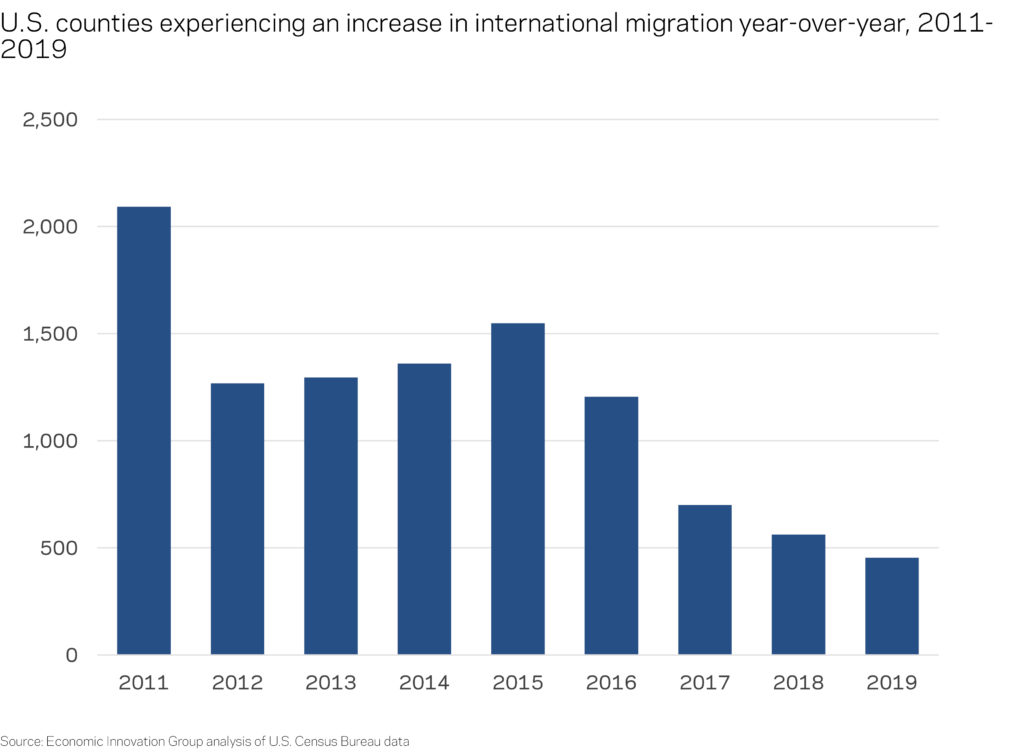
Wrong move, wrong time
The Trump Administration’s latest steps to restrict legal immigration coincide with broader demographic transformations that are rapidly reducing the rate of U.S. population growth. This demographic stagnation threatens to slow economic growth and depresses the country’s already-imperiled economic dynamism. Locally, many parts of the country are losing working age adults and need immigrants to shore up their workforces and local tax bases.
Over the last decade, the U.S. population grew at its slowest pace since the Great Depression thanks to a shifting age structure and low fertility rates. COVID-19 is expected to suppress population growth even further in the years to come, with one estimate predicting a decline of 300,000 to 500,000 births in 2020 from the already record low levels set last year.
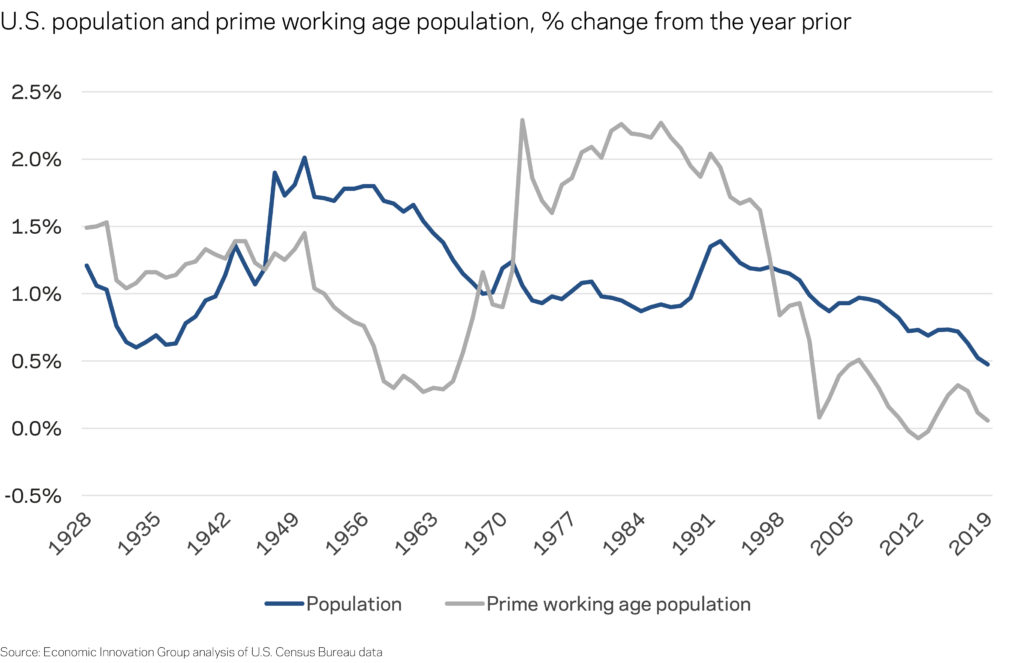
The national slowdown in population growth has profound local consequences. Eighty-one percent of U.S. counties, home to 158 million Americans, lost prime working age (25-54) adults from 2010 to 2019. While this trend has hit rural areas the hardest (91 percent of rural counties lost prime working age population in that time period), many large metropolitan counties have been impacted as well, including Cuyahoga County (Cleveland), which experienced an 8.3 percent decrease in prime age workers, and Queens County (NYC), which saw its prime age workers decrease by 4.6 percent over the decade.
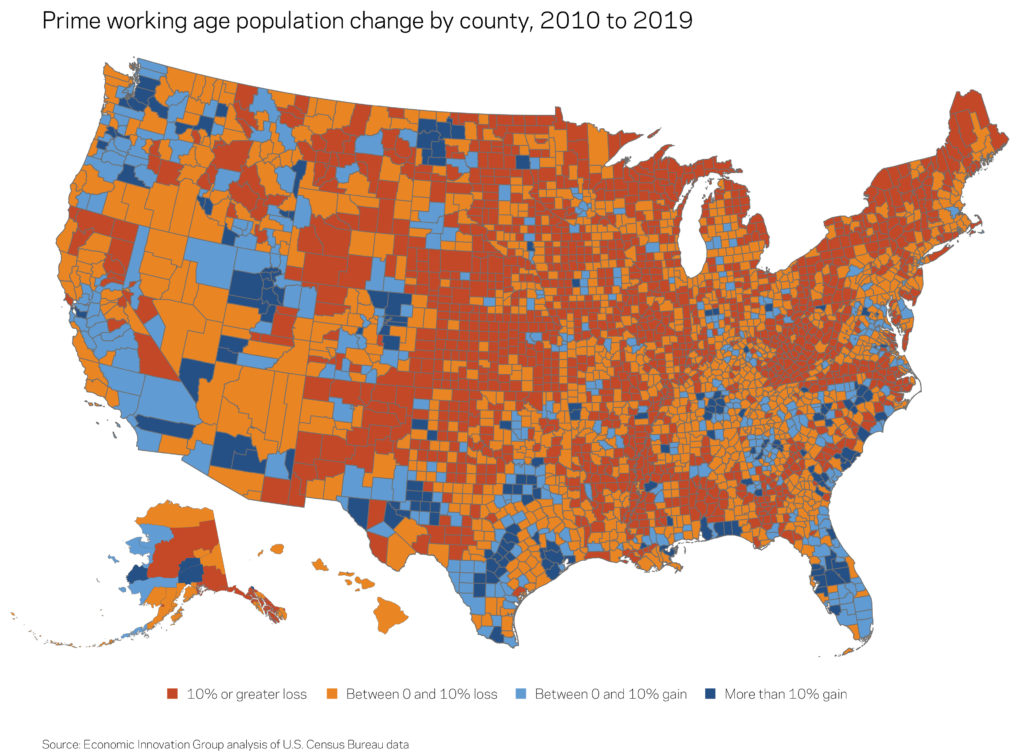
Such demographic headwinds will make it harder for these places to rebound from the pandemic. Research from EIG and Moody’s Analytics found that a 1 percentage point decline in annual population growth from 2007 to 2017 reduced a metro area’s startup rate by 2 to 3 percentage points. To make matters worse, many local governments are facing a fiscal cliff due to the COVID recession. Immigrants, and especially skilled immigrants, not only support local economies through consumer spending and business formation but also by paying taxes.
Even in a recession, immigrants don’t take American jobs
Broad claims that immigrants steal American jobs fail to reflect a much more nuanced labor market in which immigrants work together with domestic workers to create a vibrant economy. No labor market is a zero-sum game in which there is a limited supply of jobs that domestic and foreign workers must fight over. While there are some anecdotal exceptions and empirical evidence that certain low-wage workers come into more direct competition for employment with immigrants with limited education, the lump of labor fallacy is one of the most recurrently disproven themes in economics.
This is especially true for skilled immigrants. Employer-sponsored visas are responsive to market conditions and must always be tied to the scarcity of a given skillset. In general, immigrants on employer-based visas fill essential jobs that complement American ones. Immigrants fill labor gaps throughout the economy—from agricultural workers in jobs few Americans want to highly-technical STEM jobs and, especially relevant now, essential healthcare jobs in poor and remote areas. The Administration’s blanket-ban approach threatens to starve American companies and communities of critical skills at a time Washington should be securing as much certainty for the American economy as possible.
The zero-sum world-view also ignores the essential role that immigrants play in creating jobs. In actuality, immigrants are more than twice as likely than American citizens to start a new business. Around one out of four entrepreneurs in the United States is an immigrant, and the share is even greater for founders of high-growth firms backed by venture capital. There is already evidence showing that the COVID-19 recession is stifling new business formation, which will only compound the pandemic’s lasting damage to the economy. Coming out of the crisis, entrepreneurs—native-born and foreign—will be more essential than ever in building up the economy and powering a jobs-rich recovery.
Lastly, there is a critical mismatch between sectors where employer-based visas (especially skilled ones) are common and where job losses are accruing. Job losses due to the pandemic have been heaviest in sectors that have relatively low levels of legal, skilled immigrants. More than half of H-1B visa holders are employed in the professional and technical services sector, which only experienced a 5.2 percent decline in employment from February 2020 to May 2020. The hardest hit sector, Arts, Entertainment & Recreation, which experienced a 52.6 percent loss in jobs since February 2020, only employs 0.1 percent of H-1B holders. Blocking the flow of H-1B holders and hitting pause on the already backlogged green card permitting system will only serve to throw cold water on America’s tech and advanced industry sector without actually helping to get laid-off Americans back to work.
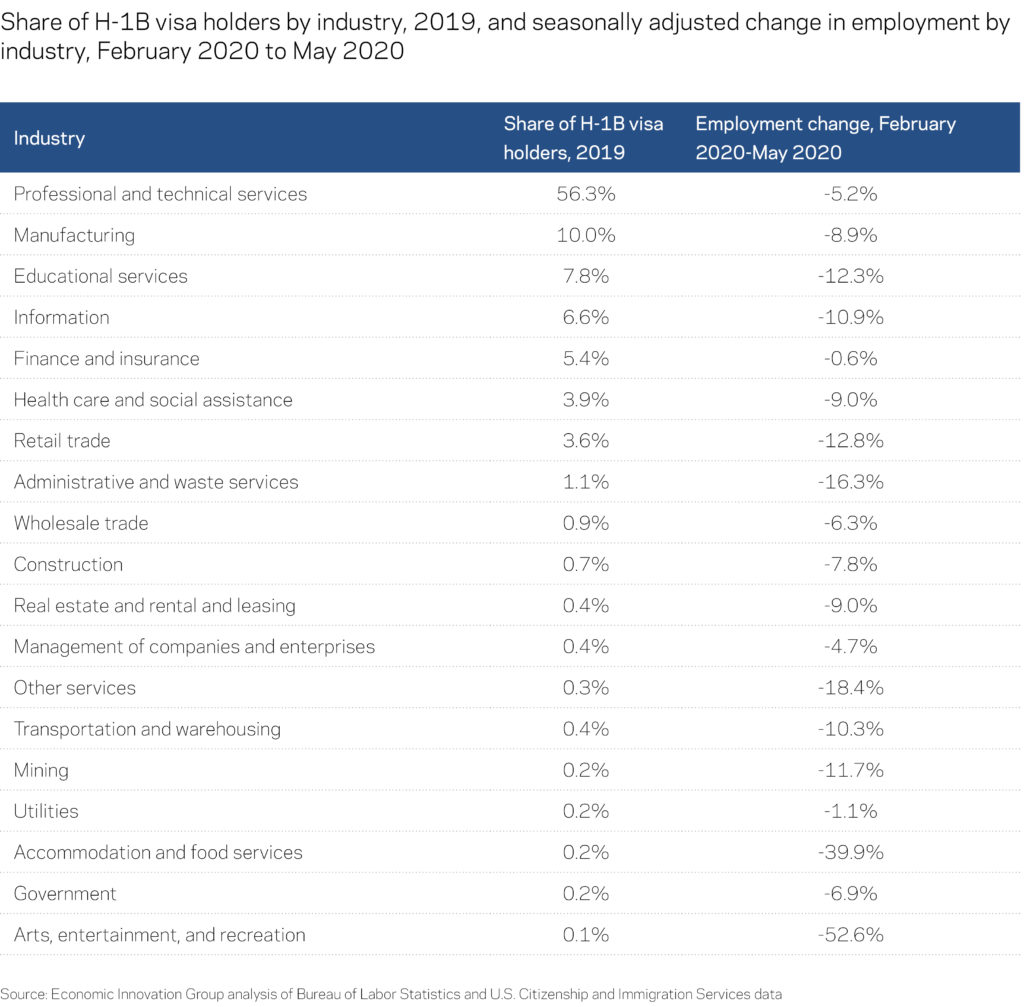
Immigrants are the lifeblood of the metro areas that will power the recovery
Immigrants in general and skilled immigrants in particular are the lifeblood of many successful metropolitan areas—the very places that are likeliest to drive the national recovery from COVID-19. Policy moves to block immigration risk depriving the country’s most dynamic regional economies of essential ingredients and risk slowing the entire nation’s recovery in the process.
Although only around 5 percent of the U.S. population over the age of 25 is composed of skilled immigrants (defined here as foreign-born workers with a bachelor’s degree or higher), in some metro areas this share is much higher. In Santa Clara County, California, the hub of Silicon Valley, the share is 26.9 percent, and in Fort Bend County, Texas, part of the Houston metro area and one of the fastest growing counties in the United States, it’s 19.2 percent. The average unemployment rate in April 2020 for the 20 counties with the highest share of skilled immigrants was 11.6 percent, well below the national unemployment rate of 14.6 percent in April. Other skilled immigrant-rich enclaves include engineering hubs across the Midwest such as Detroit, MI, and Columbus, IN, as well as college towns that drive several of the most dynamic regional economies in the heartland. In reality, numerous heartland-based global champions are only able to retain their footprints in small and mid-sized cities because of their ability to supplement scarce local workers with those from abroad. The clear lesson here is that immigration bolsters, rather than harms, local economies.
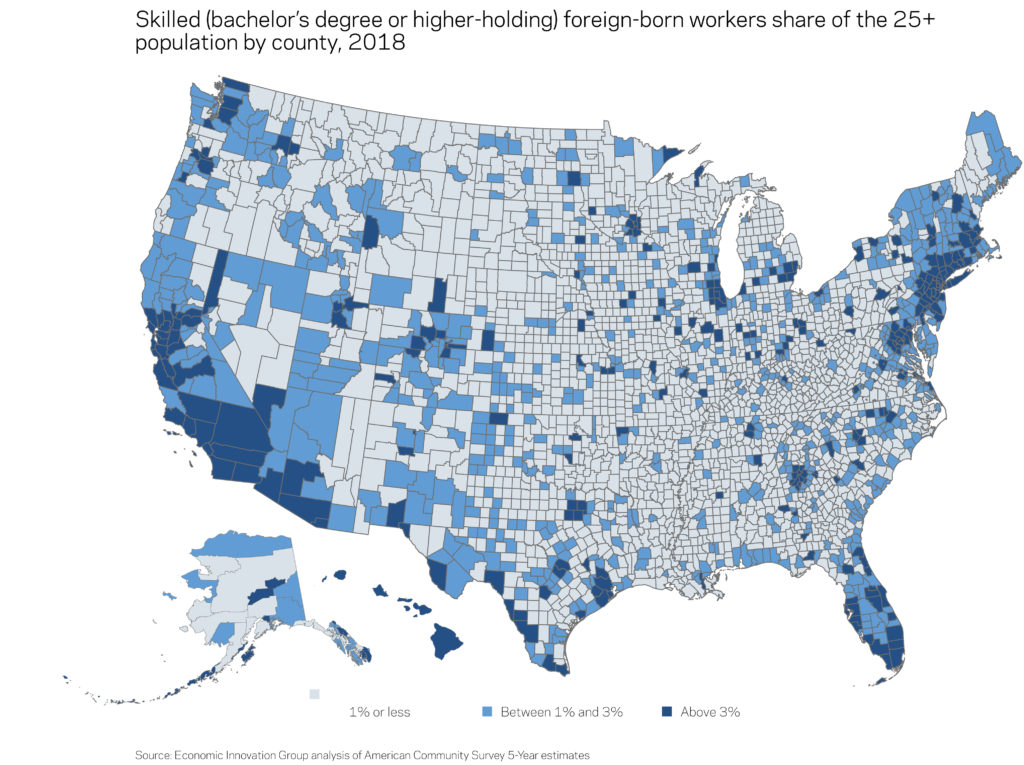
A different approach is needed
Immigrants in general and skilled immigrants in particular are exactly the fortifications the country needs for a dynamic, jobs-rich recovery. Better than the Administration’s restrictive approach would be to treat legal immigration as the strategic tool that it is. The United States should be rolling out the red carpet to skilled workers from Hong Kong, as other countries are doing. Now is the time to finally establish a startup visa to bring the innovators and entrepreneurs to the United States who can power a strong recovery and bring us back to full employment as soon as possible.
And the country’s many struggling, depopulating communities need additional injections of human capital to reinforce their economies. A Heartland Visa that would allow economically struggling communities facing low to no population growth to welcome new skilled immigrants would shore up their human capital bases. This in turn could prime more American metro areas and rural regions for a strong bounce-back from the COVID-recession.
The administration’s claim that freezing H-1B visas and green card permits is intended to protect American jobs is belied by its concerted efforts to dramatically scale back legal immigration over the past few years. Instead of scheming up new ways to shut the country’s border to a beneficial pipeline of entrepreneurial, hard-working immigrants, we should be envisioning how to build an immigration system that works and energizes local economies across the country.




